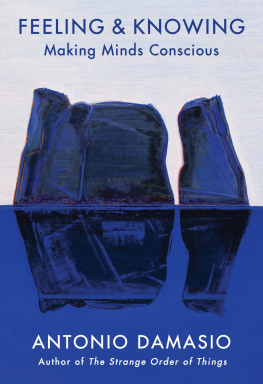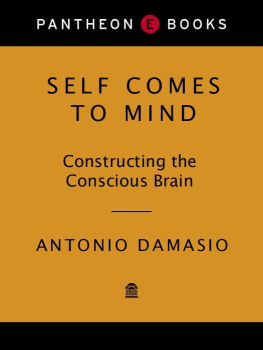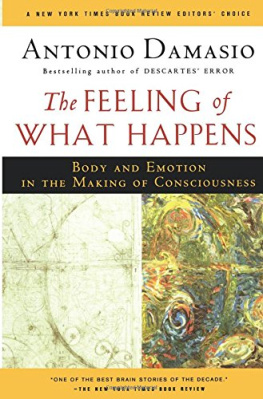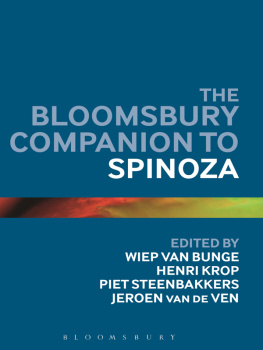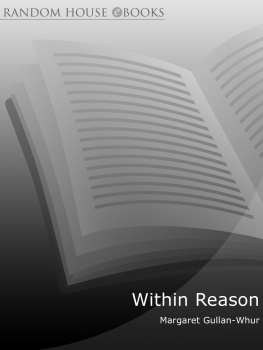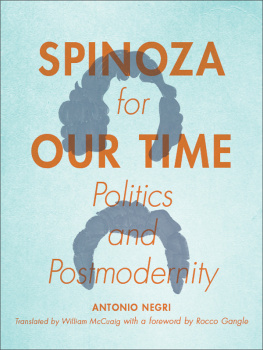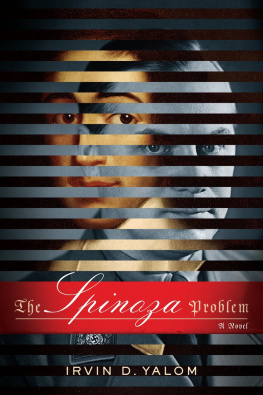Looking for Spinoza
Joy, Sorrow, and the Feeling Brain
Antonio Damasio
A H ARVEST B OOK
H ARCOURT , I NC .
Orlando Austin New York San Diego Toronto London
Copyright 2003 by Antonio Damasio
All rights reserved. No part of this publication may be reproduced or transmitted in any form or by any means, electronic or mechanical without permission in writing from the publisher.
Requests for permission to make copies of any part of the work should be mailed to the following address: Permissions Department,
Harcourt, Inc., 6277 Sea Harbor Drive, Orlando, Florida 32887-6777.
www.HarcourtBooks.com
Library of Congress Cataloging-in-Publication Data
Damasio, Antonio R.
Looking for Spinoza: joy, sorrow, and the feeling brain/
Antonio Damasio.1st ed.
p. cm.
Includes bibliographical references and index.
ISBN 0-15-100557-5 ISBN 0-15-602871-9 (pbk.)
1. Emotions. 2. Neuropsychology. 3. Spinoza, Benedictus de, 16321677.
I. Title.
QP401.D203 2003
152.4d21 2002011347
All figures, diagrams, and drawings are by Hanna Damasio except for the portrait on page 263. Her drawings in Chapters 1, 5, and 6 depict Spinoza's house on 72-74 Paviljoensgracht (page 9), a statue of Spinoza (page 16), the back of the New Church and Spinoza's tomb in The Hague (page 19), the Portuguese Synagogue in Amsterdam (page 185), the house where Spinoza lived in Rijnsburg (page 223), a bust of Spinoza (page 225), and the old synagogue in Amsterdam (inspired by a 17th century engraving by Jan Veenhuysen). The portrait on page 263 is by Jean Charles Franois and was published by A. Savrien, Histoire des Philosophes Modernes, Paris, 1761.
Text set in Scala
Designed by Linda Lockowitz
Printed in the United States of America
First Harvest edition 2003
K J I H G F E D C B A
To Hanna
Contents
C HAPTER 1 Enter Feelings
Enter Feelings 3
The Hague 8
Looking for Spinoza 15
Beware 17
In the Paviljoensgracht 23
C HAPTER 2 of Appetites and Emotions
Trust Shakespeare 27
Emotions Precede Feelings 29
A Nesting Principle 37
More on the Emotion-Related Reactions: From Simple Homeostatic Regulation to Emotions-Proper 38
The Emotions of Simple Organisms 40
The Emotions-Proper 43
A Hypothesis in the Form of a Definition 53
The Brain Machinery of Emotion 54
Triggering and Executing Emotions 57
Out of the Blue 65
The Brain Stem Switch 73
Out-of-the-Blue Laughter 74
Laughter and Some More Crying 77
From the Active Body to the Mind 79
C HAPTER 3 Feelings
What Feelings Are 83
Is There More to Feelings than the Perception of Body State? 89
Feelings Are Interactive Perceptions 91
Mixing Memory with Desire: An Aside 93
Feelings in the Brain: New Evidence 96
A Comment on Related Evidence 101
Some More Corroborating Evidence 104
The Substrate of Feelings 105
Who Can Have Feelings? 109
Body States versus Body Maps 111
Actual Body States and Simulated Body States112
Natural Analgesia 113
Empathy 115
Hallucinating the Body 118
The Chemicals of Feeling 119
Varieties of Drug-Induced Felicity 121
Enter the Naysayers 124
More Naysayers 126
C HAPTER 4 Ever Since Feelings
Of Joy and Sorrow 137
Feelings and Social Behavior 140
Inside a Decision-Making Mechanism 144
What the Mechanism Accomplishes 147
The Breakdown of a Normal Mechanism 150
Damage to Prefrontal Cortex in the Very Young152
What If the World? 155
Neurobiology and Ethical Behaviors 159
Homeostasis and the Governance of Social Life166
The Foundation of Virtue 170
What Are Feelings For? 175
C HAPTER 5 Body, Brain, and Mind
Body and Mind 183
The Hague, December 2,1999 184
The Invisible Body 187
Losing the Body and Losing the Mind 191
The Assembly of Body Images 195
A Qualification 198
The Construction of Reality 198
Seeing Things 200
About the Origins of the Mind 204
Body, Mind, and Spinoza 209
Closing with Dr. Tulp 217
C HAPTER 6 A Visit to Spinoza
Rijnsburg, July 6, 2000 223
The Age 224
The Hague, 1670 227
Amsterdam, 1632 230
Ideas and Events 236
The Uriel da Costa Affair 240
Jewish Persecution and the Marrano Tradition245
Excommunication 250
The Legacy 254
Beyond the Enlightenment 258
The Hague, 1677 261
The Library 262
Spinoza in My Mind 263
C HAPTER 7 Who's There?
The Contented Life 267
Spinoza's Solution 273
The Effectiveness of a Solution 277
Spinozism 279
Happy Endings? 283
Appendices 291
Notes 299
Glossary 333
Acknowledgments 337
Index 339
Chapter 1
Enter Feelings
Enter Feelings
Feelings of pain or pleasure or some quality in between are the bedrock of our minds. We often fail to notice this simple reality because the mental images of the objects and events that surround us, along with the images of the words and sentences that describe them, use up so much of our overburdened attention. But there they are, feelings of myriad emotions and related states, the continuous musical line of our minds, the unstoppable humming of the most universal of melodies that only dies down when we go to sleep, a humming that turns into all-out singing when we are occupied by joy, or a mournful requiem when sorrow takes over.
Given the ubiquity of feelings, one would have thought that their science would have been elucidated long agowhat feelings are, how they work, what they meanbut that is hardly the case. Of all the mental phenomena we can describe, feelings and their essential ingredientspain and pleasureare the least understood in biological and specifically neurobiological terms. This is all the more puzzling considering that advanced societies cultivate feelings shamelessly and dedicate so many resources and efforts to manipulating those feelings with alcohol, drugs of abuse, medical drugs, food, real sex, virtual sex, all manner of feel-good consumption, and all manner of feel-good social and religious practices. We doctor our feelings with pills, drinks, health spas, workouts, and spiritual exercises, but neither the public nor science have yet come to grips with what feelings are, biologically speaking.
I am not really surprised at this state of affairs, considering what I grew up believing about feelings. Most of it simply was not true. For example, I thought that feelings were impossible to define with specificity, unlike objects you could see, hear, or touch. Unlike those concrete entities, feelings were intangible. When I started musing about how the brain managed to create the mind, I accepted the established advice that feelings were out of the scientific picture. One could study how the brain makes us move. One could study sensory processes, visual and otherwise, and understand how thoughts are put together. One could study how the brain learns and memorizes thoughts. One could even study the emotional reactions with which we respond to varied objects and events. But feelingswhich can be distinguished from emotions, as we shall see in the next chapterremained elusive. Feelings were to stay forever mysterious. They were private and inaccessible. It was not possible to explain how feelings happened or where they happened. One simply could not get "behind" feelings.


